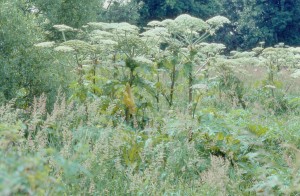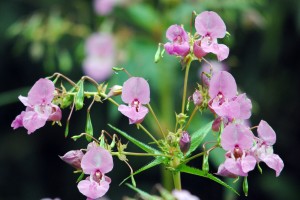Basin Notes – 10th June
Invasive Aliens take over Montrose Basin
It may sound a little dramatic, but invasive aliens have been taking hold at the Montrose Basin LNR for some years now. Though extraterrestrial life hasn’t been discovered on the East coast of Scotland, terrestrial invasive species are prolific here. I am of course referring to the invasive non-native plant species giant hogweed and Himalayan balsam. Many non-native plants were introduced to the UK during the 19th Century for ornamental purposes. Having these exotic species in your garden was a huge status symbol; sadly little was known of their nature and how the plants would react in a new environment. Of the introduced invasive plants now well established in the UK, giant hogweed and Himalayan balsam are the problem species on the Montrose Basin Local Nature Reserve.

Typically reaching 3-5 meters in height, giant hogweed is the Goliath of invasive plant species. Divided and sharply pointed leaves can grow to over a meter wide, while the hollow stem reaches at least 10 centimetres in diameter. The plant will only flower once in its lifetime when it has reached a certain size and gathered enough resources to seed successfully, but it can suppress flowering for up to 12 years making it very tolerant to grazing. When it does flower, many small white flowers are grouped together in clusters known as ‘umbels’. These umbels form at the top of the plant resembling an umbrella. Due to its scale and unusual appearance, it is clear why this plant was once desired in gardens as an exotic import from South-West Asia; acting as an expression of wealth, but this impressive plant has a more sinister dimension… It is covered in bristles which release a sap when broken or touched that causes a harmful reaction known as phototoxicity when in contact with human skin. This means 15-20 hours after contact, skin can blister and a rash may develop when exposed to sunlight. Symptoms may persist years after the initial contact. Unfortunately the large, hollow stem appeals to children as a ‘pea shooter’ or ‘telescope’ placing them at risk of painful blisters around the mouth and eyes.
Himalayan balsam may not be directly hazardous to human health, but the impact both of these species has on the environment affects us all. Released in 1839 from the Western Himalayas, this plant can grow to 3 meters tall with a pink slipper-shaped flower in June. Though this is a very attractive plant it is bad news for the environment for many reasons.

Both Himalayan balsam and giant hogweed are very successful invasive species. Part of this success is down to the amount of seeds they can produce. Each giant hogweed plant can release between 10,000 and 20,000 seeds in its lifetime, though this will only happen once. Each Himalayan balsam plant can produce 700 seeds each year in exploding seed-pods which can disperse up to 7 meters. Both plants’ seeds are easily transported along watercourses. Our native plants are out-competed, leading to monoculture which impedes biodiversity. Giant hogweed leaves begin to grow early in the season which gives this plant the edge at its most vulnerable stage; beyond this the scale of the plant means other native species are unable to survive as they are shaded out by the large umbels and leaves towering overhead. When the plant dies after it has reached flowering age, the ground is left bare which can lead to erosion on riverbanks. Himalayan balsam has shallow roots that cope well with poor soil conditions. It grows in dense stands, suppressing all native flora. Again erosion is a concern as once the plant has died off in the Autumn, river banks are left exposed.
When one species can out-compete others in this way, biodiversity is threatened. Since the impact on our wildlife is such a concern, legislation is in place in the form of the Wildlife and Natural Environment (Scotland) Act 2012, making it an offence to release non-native species into the wild – whether intentional or not.
Where non-native species are already established, we should all see it as our responsibility to help control and eradicate them. At the Montrose Basin LNR, the area affected by Himalayan balsam and giant hogweed is where the river joins the basin. The seed travels downstream from dispersal further up the catchment making the area particularly vulnerable. Scottish Wildlife Trust is working with other members of the River South Esk catchment to address the problem with the whole catchment in mind. However, this huge task requires a lot of manpower.
If you would like to help eradicate invasive aliens at Montrose Basin, why not get involved with Himalayan balsam control and learn more about the reserve, at one of our FREE Practical Volunteer Days on 22nd July and 12th August. Booking is essential, just call the Montrose Basin Visitor centre to secure a place: 01674 676 336.
Anna Cheshier – Montrose Basin Ranger
Help protect Scotland’s wildlife
Our work to save Scotland’s wildlife is made possible thanks to the generosity of our members and supporters.
Join today from just £3 a month to help protect the species you love.
Preface
Invasive Aliens take over Montrose Basin It may sound a little dramatic, but invasive aliens have been taking hold at the Montrose Basin LNR for some years now. Though extraterrestrial life …
